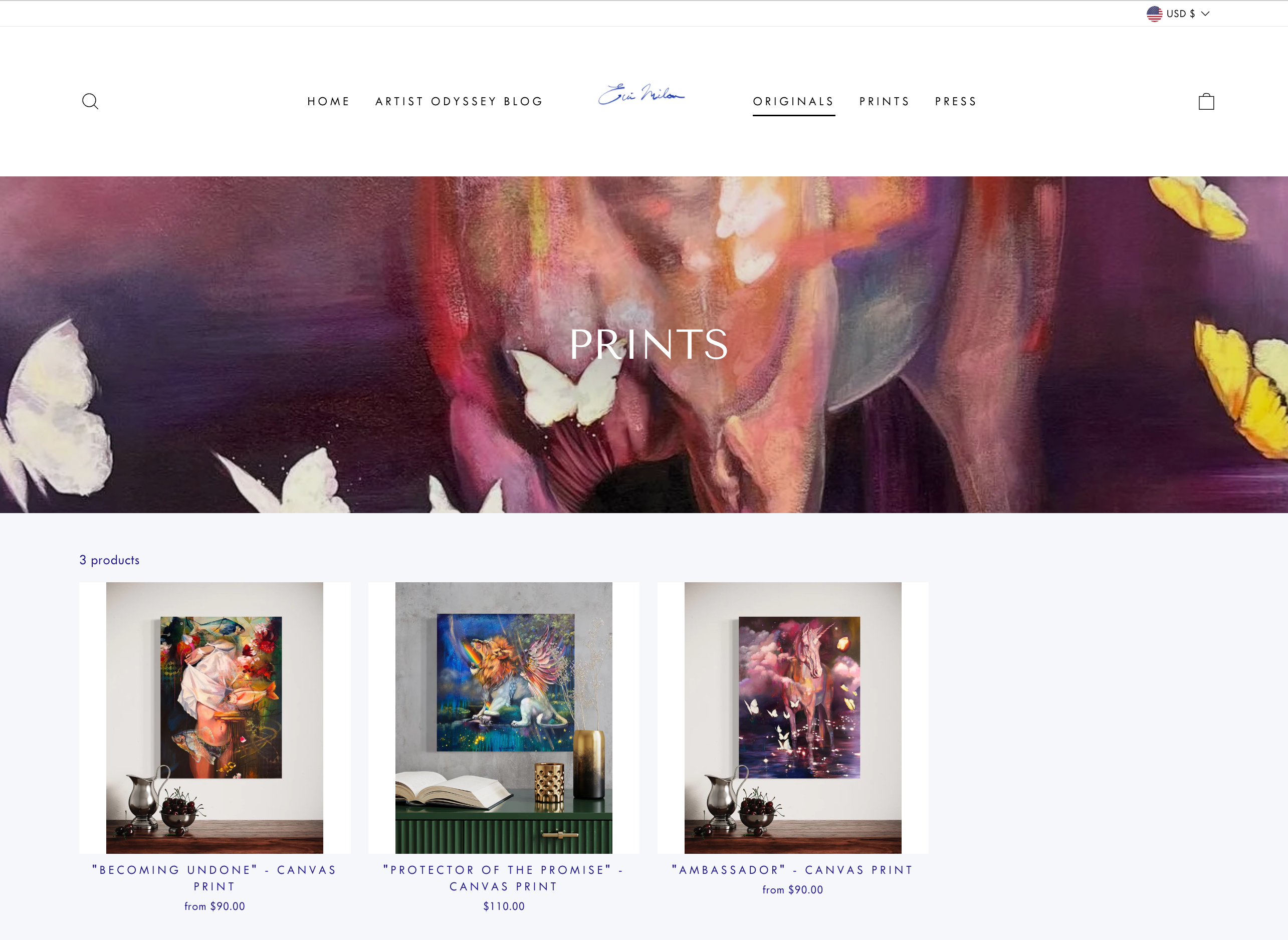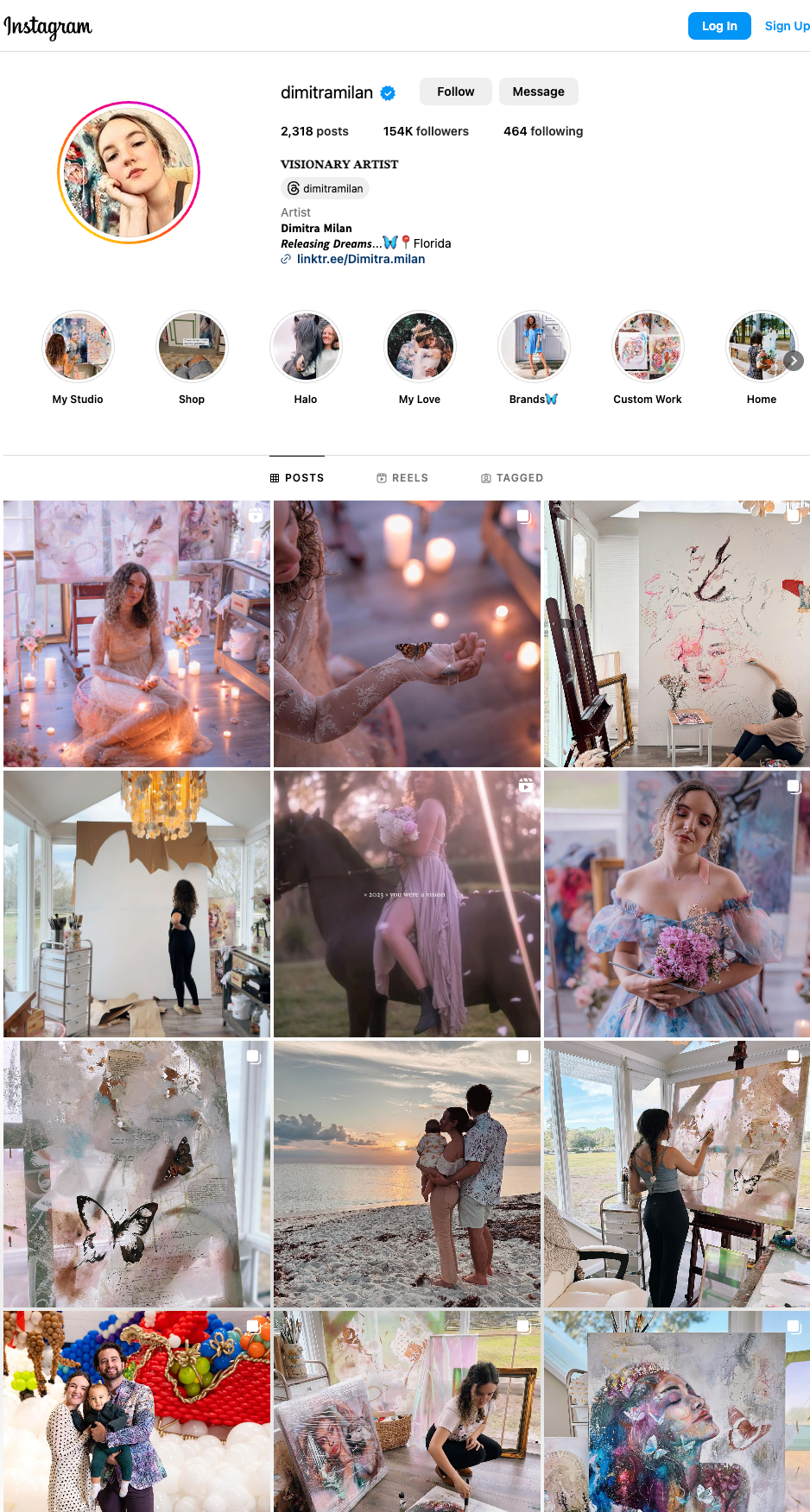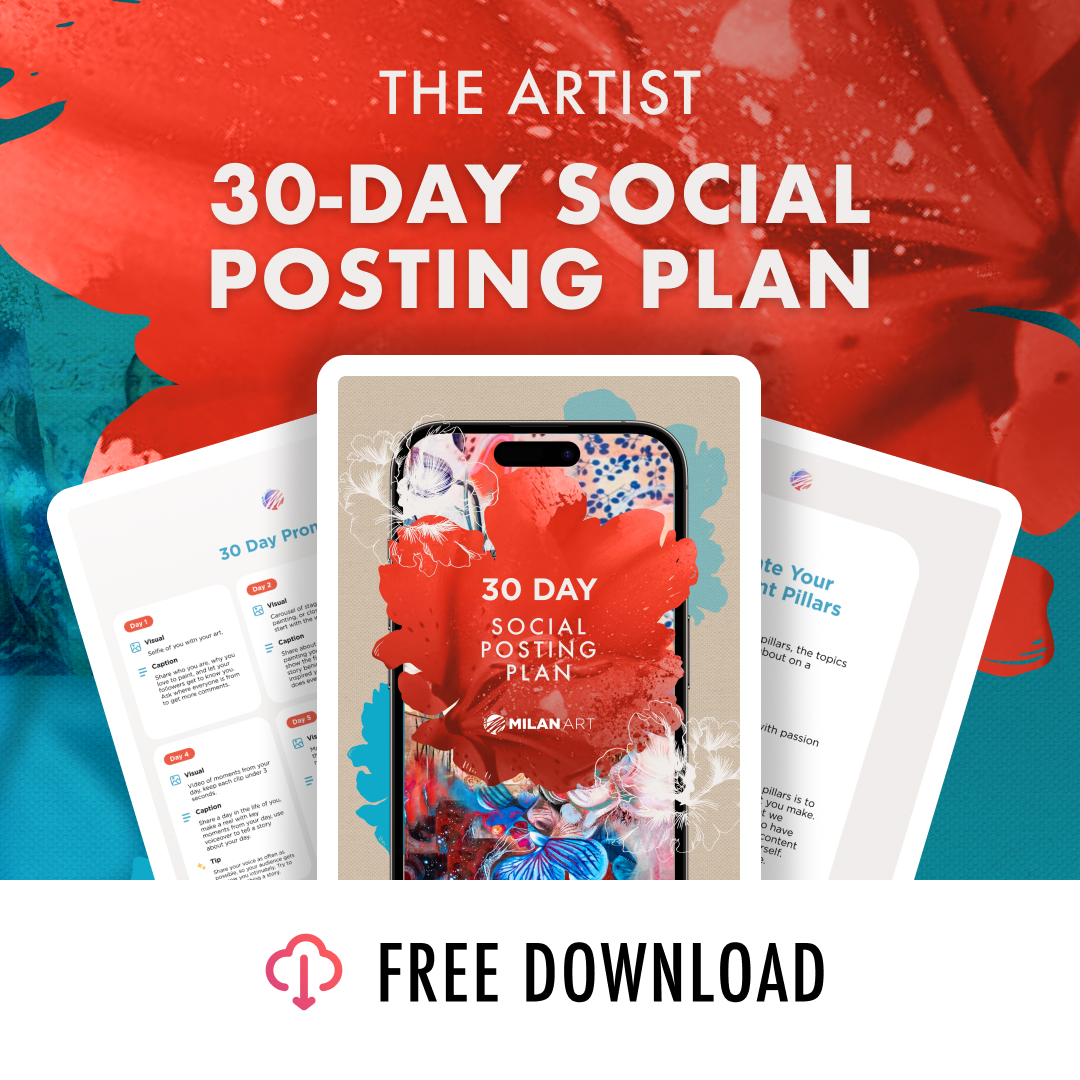The digital age has opened the floodgates for creative entrepreneurs—and artists are uniquely positioned to thrive.Whether you're a painter, illustrator, or mixed media maker, there’s never been a better time to turn your passion into profit. With the right strategies, you can build a thriving art business from your laptop, connect with collectors around the world, and grow a brand that’s authentically you. Ready to make your mark? Here are six quick and practical tips to help you launch an art business with confidence.
1 - Craft Your Online Art Business Plan

Whether you aim to create an online art store, sell digital artwork, or establish your online gallery, a comprehensive business plan is the foundation of your own art business.
An artist business plan is your step-by-step guide to building a successful business. It outlines your:
- artistic vision and art style
- target market and ideal collector
- competition in the art world
- marketing strategy
- financial plan, including your projected online sales and profit margin
A profitable business is not an accident; it results from careful planning, hard work, and a commitment to blazing your trail in the creative market so you can sell your art.
Do you envision developing an art brand and creating custom art you can sell online? Find the skills you need to practice to become a professional artist in this fascinating conversation with Jake Dunn, Dimitra Milan, and Elli Milan.
2 - Find Your Niche and Identify Your Ideal Collector
Finding your niche in the art market can help you create sellable art and develop an effective marketing strategy. With so many artists producing stunning artwork, knowing your niche can help you stay focused on creating authentic art you enjoy and your potential customers want.
Define your ideal collector by considering location, age, occupation, interests, and buying behavior relevant to your art.
Whether you aim to offer digital art, print-on-demand services, or digital prints from your store online, a detailed profile of your ideal collector can help you tailor your offerings and marketing messages to serve your audience better and grow your art business.
3 - Build a Professional Portfolio Website

A professional website or online portfolio is essential to sell art online. Your website is a reflection of your brand and a powerful tool for engaging with your audience and selling your artwork.
Your portfolio website is the foundation of your online platform and should include the following elements:
- Unique branding
- Your artist statement
- A diverse range of work
- High-quality images
- Your CV (or artist bio example: education, awards, exhibitions, and other achievements)
- Engaging descriptions of each piece
- Contact details or a contact form
Create your art portfolio to reflect your brand and showcase your unique artistic style, making it instantly recognizable to visitors. It should engage potential collectors, provide a deeper understanding of your work, and make it easy for patrons to discover and contact you.
Once you have a beautifully crafted website, the next step is to turn it into your online store. This involves integrating e-commerce solutions into your website to manage inventory and transactions and ensure a seamless shopping experience for your collectors.
A website designer can create a custom website for you, but you can also create your own website. To do this, you'll need a website builder. Here are a few popular website builders that are suitable for artists who want to make money selling art online:
Shopify
- Features: Shopify offers a dedicated, easy-to-use website builder with built-in e-commerce features. It offers customizable templates, a secure checkout, and the ability to manage inventory.
- Ease of Use: Shopify is user-friendly, particularly for those focused on selling products online. It might have a steeper learning curve than general-purpose website builders, but it provides robust e-commerce features.
- Pricing: Shopify has monthly subscription plans, and there's an additional transaction fee unless you use Shopify Payments.
Wix
- Features: Wix offers a drag-and-drop website builder with various templates suitable for artists. It provides features like galleries, image sliders, and customizable layouts. There's also an online store option.
- Ease of Use: Wix is known for its user-friendly interface and doesn't require coding skills. The drag-and-drop editor allows easy customization of the website's look and feel.
- Pricing: Wix has a free plan with a Wix-branded domain and ads. Premium plans, which allow for a custom domain and remove ads, start at a monthly fee. The eCommerce plan is necessary to sell art online.
Squarespace
- Features: Squarespace provides artist-friendly templates and a range of features, including image galleries, blogging, and integrated e-commerce capabilities. It's known for its sleek and modern designs.
- Ease of Use: Squarespace is user-friendly with a visually intuitive editor. It's a good option for artists who want a professional-looking site without spending too much time on customization.
- Pricing: Squarespace offers subscription plans with different features. It includes hosting, and there's an additional transaction fee for e-commerce transactions.
Cargo
- Features: Cargo is a website builder specifically designed for artists and creatives. It provides customizable templates, an image-focused interface, and features like password-protected pages for private portfolios.
- Ease of Use: Cargo is relatively easy to use, and its focus on visual content makes it suitable for artists. It's not as widely known as some other platforms but is worth exploring for its specialization.
- Pricing: Cargo has subscription plans with various features, including options for personal portfolios and business sites.
Format
- Features: Format is a website builder tailored for creatives, including artists and photographers. It offers customizable templates, e-commerce capabilities, and a client-proofing feature for artists who work with clients.
- Ease of Use: Format is known for its simplicity and ease of use. It's designed to showcase visual content effectively and allows for easy customization without needing coding skills.
- Pricing: Format offers subscription plans, including a free trial. Pricing varies based on the features you need, and there's an additional fee for e-commerce functionality.
WooCommerce
- Features: WooCommerce is a WordPress plugin that adds e-commerce functionality to your existing WordPress site. Artists can leverage the flexibility of WordPress and add features like galleries, blogs, and more.
- Ease of Use: It requires a bit more technical know-how than some dedicated website builders, but for those comfortable with WordPress, it offers a powerful solution for selling art online.
- Pricing: WooCommerce is a free plugin, but you'll need a WordPress site, which may involve costs for hosting and domain. Additional expenses may include premium themes and extensions.
Each platform has strengths; the choice ultimately depends on your preferences and goals.
4 - Diversify Revenue Streams

As an artist, your creativity extends beyond your art to your business model, marketing strategies, and revenue streams. Diversifying your revenue streams can increase your income and stabilize the art market.
A few strategies to diversify your revenue streams include:
- Print-on-demand
- Merchandise
- Educational products and services
You can sell physical art prints and customized print-on-demand products—like tote bags, stickers, and t-shirts—at different price points without managing inventory.
While print-on-demand platforms offer ease of use and lower upfront costs, they tend to result in lower profit margins for the artists.
Offering art-related merchandise is another way to diversify your revenue streams and sell art. Merchandise options range from art printed on common items like hats, iPhone cases, and mugs to niche art products like enamel pins and stationery.
You can also leverage your designs by creating repeat prints on fabric, wrapping paper, or wallpaper or offer custom commissions on merchandise, such as personalized portraits on mugs and t-shirts.
Teaching, workshops, and other educational products empower you to share your expertise to help budding artists while generating an additional revenue stream.
5 - Find the Right Online Marketplace to Sell Your Art
 There are various platforms where you can sell art online, each offering unique advantages. The marketplace you choose can have a significant impact on your online art sales.
There are various platforms where you can sell art online, each offering unique advantages. The marketplace you choose can have a significant impact on your online art sales.
Some popular online marketplaces include:
Etsy
- Target Audience: Etsy is a diverse marketplace that caters to a wide range of artists and crafters. It's known for handmade, vintage, and unique items, including original artwork.
- Fee Structure: Etsy charges a listing fee for each item, a transaction fee when a sale occurs, and payment processing fees. Specific fee percentages may vary.
- Unique Features: Etsy is well-known for its community feel, allowing artists to connect with buyers directly. It's also user-friendly and has a large customer base.
Saatchi Art
- Target Audience: Saatchi Art, a platform for buying and selling original art and renowned for its curated selection of fine art pieces, is geared towards contemporary artists. It aims to connect fine artists with collectors and enthusiasts.
- Fee Structure: Saatchi Art charges a 35% commission on sales, but there are no fees for listing and handling transactions. Artists set their prices for their works.
- Unique Features: Saatchi Art provides a curated platform featuring new artists alongside established names. They offer services like art advisory and the ability to sell limited edition prints.
Artfinder
- Target Audience: Artfinder focuses on connecting artists with art buyers globally. It emphasizes discovery and supports emerging artists.
- Fee Structure: Artfinder charges a 33% commission on sales. Artists can list an unlimited number of artworks for free.
- Unique Features: Artfinder uses a "taste profile" to help buyers discover art that matches their preferences. The platform also has a strong emphasis on promoting independent artists.
RedBubble
- Target Audience: Redbubble is a marketplace for artists who create graphic or digital art. It allows artists to upload designs for various products like clothing, stickers, and home decor.
- Fee Structure: Redbubble sets a base price for products, and artists earn a markup. The artist's earnings are the difference between the base price and the selling price.
- Unique Features: Redbubble offers a wide array of products with artists' designs, and it's known for its print-on-demand model. Artists can reach a global audience without handling production or shipping.
Society6
- Target Audience: Society6 is similar to Redbubble, catering to artists who create digital or graphic art. It offers a variety of products featuring artists' designs.
- Fee Structure: Artists earn a commission on each sale, and Society6 handles production, shipping, and customer service. Society6 sets pricing.
- Unique Features: Society6 focuses on art-inspired lifestyle products, allowing artists to showcase their designs on home decor, tech accessories, and apparel.
Fee structures and features may change, so check the latest information on each platform's website.
6 - Leverage Social Media Platforms
 Social media provides a platform to showcase your art, connect with your audience, and sell your artwork.
Social media provides a platform to showcase your art, connect with your audience, and sell your artwork.
To create excitement around your art and drive traffic to your website, use storytelling to share the inspiration and experience behind each creation. Post content like:
- Countdowns
- Product previews
- Behind-the-scenes photos from your art studio
- Videos of the creative process
- Interviews with other artists or experts in your field
- Blog posts or articles discussing your inspiration or techniques
Social media can also help you connect with art collectors and enthusiasts, build direct relationships with your audience, and foster a loyal community around your art.
Consider paid advertising and collaborations to broaden your reach significantly.
Launch Your Art Career and Sell Art Online

Free 30-Day Social Posting Plan to maximize your social media accounts and start selling art online
Are you ready to sell your art online? Save time and find lots of inspiration for engaging with your social media audience with this FREE 30-Day Social Content Plan. Download it now to eliminate the guesswork and learn the tips, tricks, and tools to help you gain confidence in building your online artist platform.
Why Milan Art Institute?
Your Path to Artistic Mastery Starts Here
At the Milan Art Institute, we blend passion with expertise to help you unlock your artistic potential. Our Mastery Program and online art classes are designed for artists at all levels, providing step-by-step guidance and personalized support from seasoned professionals. Whether you're looking to refine your skills, discover new techniques, or build your artistic career, our courses offer the tools and insights you need. Join our vibrant community and transform your art journey with tailored instruction and a supportive environment.
What Our Students Are Saying

